#animationblog
Explore tagged Tumblr posts
Text
Lotte Reiniger (1920s): An Inspiration to Modern Animation Directors
(10 minutes reading)
By Sofi Ojeda

Lotte Reiniger was a talented German artist born in Berlin, she displayed remarkable, self-taught skills in creating intricate paper silhouettes from an early age. She incorporated these silhouettes into her homemade shadow theater with the influences she drew from traditional Asian shadow plays. Reiniger's talent led to an introduction to her later partner Koch, who not only designed her animation studio but also served as her producer and camera operator until his death in 1963.
Reiniger's enduring fascination with timeless fairy tales permeated her animations, including notable works such as "Aschenputtel" (Cinderella) and "Dornröschen" (The Sleeping Beauty) from 1922. However, her most remarkable achievement was "The Adventures of Prince Achmed," a pioneering project created in collaboration with her husband and others over three years, celebrated as the first full-length animated film in history.

Although, Reiniger created various works in different countries before and after the war, she never ventured into another full-length feature film. Nevertheless, her unique animation style continues to exert a profound influence on a diverse range of cinematic creations, from Disney classics to the enchanting world of Harry Potter, leaving an indelible mark on the realm of animation.
Pioneering Techniques

Furthermore, Reiniger's legacy transcends her era, as her pioneering techniques, including cut-out animation (where body parts are separated and manipulated with anchor points and a skeletal structure). And her silhouette art underscores one of the most recognized design principles—silhouette—in character design and object recognition. This principle facilitates viewers' comprehension of visual information and enhances their grasp of the narrative.
Having gained insight into her techniques, let's explore some examples of her influence.
Inspiration to Animation Directors Over Time
Reiniger influence on Walt Disney

She inspired Disney to incorporate the concept of the multiplane camera into animation. This innovative camera technique involved the use of multiple layers of drawings moving at varying speeds, effectively creating a sense of depth and dimension in the video.
Reiniger influence on Tim Burton

In Tim Burton's "Corpse Bride" (2004), a traditional interpretation of Reiniger's style surfaces in a scene during the musical number 'Remains of the Day.' Utilizing silhouettes set against vibrant green backgrounds, the narrative unfolds, reminiscent of Reiniger's shadow animations.
Reiniger influence in Ford Coppola

The opening scene of Francis Ford Coppola's "Bram Stoker's Dracula" (1992) serves as a clear illustration of this phenomenon. It involves the recounting of Vlad 'The Impaler' Dracula's history, shifting from a live-action sequence to a battle montage that adopts Reiniger's distinctive artistic style.
Lotte R. influence in Harry Potter

In "Harry Potter and the Deathly Hallows – Part 1" (2010), there's a noteworthy transition from live-action to animation as Harry, Ron, and Hermione delve into 'The Tale of the Three Brothers.' To honor Reiniger's iconic storytelling style, which often resembled classic fables, the filmmakers opted for this approach
Conclution
From a gender perspective, it appears that Lotte Reiniger existed in a parallel world where her voice as a woman was not only acknowledged but also illuminated across time to the present day. It's worth noting that she seemed to be the sole practitioner of her unique animation technique, and had she worked in a male-dominated field, the course of history might have unfolded quite differently. However, I am not implying that she didn't face the challenges that were prevalent in her time.
In summation, Lotte Reiniger's contributions to the world of animation stand as a testament to her inventive spirit and pioneering endeavors. Her mastery of shadow animation, her lasting impact on modern animation techniques, and her feminist legacy collectively leave an enduring impression on the cinematic landscape. Her influence continues to inspire filmmakers and animators to this day.
Bibliography
http://www.screenonline.org.uk/people/id/528134/index.html
https://www.acmi.net.au/stories-and-ideas/lasting-legacy-lotte-reiniger/
#art#illustration#lotte reiniger#animation history#1920sanimation#earlyanimations#writing#animationblog#2d animation#animation#cutout#tim burton#walt disney#harry potter#bram stocker's dracula#francis ford coppola
11 notes
·
View notes
Text
Lés Gobelins
Number 1 animation school in the world, renown for its stunning animation styles, graphics and techniques.
0 notes
Text
It’s interesting how many different messages people are getting from Pixar’s Soul. Like it feels like no one can quite agree what it’s message is.
4 notes
·
View notes
Link
A blog post with TEA
2 notes
·
View notes
Photo

Animation of Unrecognizable Object Until It Moves Update 2
77 frames in and I think I'm about halfway done?
0 notes
Link

In most cases people get puzzled when they hear a new word in their profession. In many instances some newbies in animation have always marveled at how some terms seemed dangerous in the field. Hence, in this article we are going to learn what’s a reversal in animation, and help you get to know it and perform it. Caution it doesn’t mean getting pork instead of cucumbers.
#reversal#prayananimation#reversalinanimation#animationblog#2d animation#2danimationcompany#animationservices#animationstudio#3d animation company#animationcompany
3 notes
·
View notes
Video
Back to basics #basics #animation #3d #3danimation #maya #bouncingball #blog #animationblog #vancouver #levelingup (at Vancoucer)
0 notes
Text
Unveiling a Stop-Motion Masterpiece: 'The Tale of the Fox (1937)'
(7 min reading)
By Sofi Ojeda
In this exploration of early 20th-century animation, we delve into the captivating world of stop-motion with a focus on the animated feature film "The Tale of the Fox (1930)" by Władysław Starewicz, a Russian-Polish animator.

Before the advent of stop-motion animation, cinematic special effects primarily involved the work of visionaries like George Méliès, who conjured objects into existence or made them disappear in live-action films. Inspired by this, Władysław Starewicz showcased his early drawings, demonstrating artistic talent and a deep interest in photography, cinematography, and the world of insects, and embarked on a unique journey. He became one of the first animators to employ puppets, taxidermy, and exceptional puppet mastery to bring life to his imaginative creations in stop motion.
To discuss ‘The Tale of the Fox’ feature film, it's crucial to highlight Władysław Starewicz's animation evolution. Which started as the director of the Museum of Natural History in Kaunas, Lithuania. His foray into animation began with a stop motion short film featuring matches, but he soon transitioned to the realm of bugs, making them the stars of his emotionally charged and unconventional narratives, placing them into romantic, revenge or even lust situations (yes, with bugs).

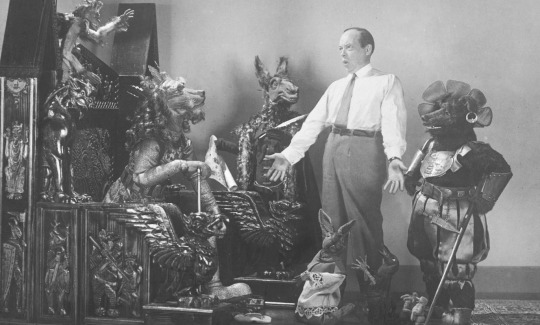
Film director Władysław Starewicz on set of 'The Tale of the Fox', 1930. Photo: www.audiovis.nac.gov.pl (NAC)
The production of his films was an arduous and meticulous process, capturing phases of movement in photography frame by frame, initially with a camera he obtained in 1909, it showcased Starewicz's complete dedication to his craft. He, along with his family, created a whole new technique. His first short films were well renowned in Europe, and they began to gain recognition in the United States.
While residing in Russia, Władysław experienced the revolution of 1937, a tough political situation, which led to the overthrow of the Russian government. Later, with the animation industry aligning with the Czar, Starewicz and his family sought refuge in France. Following the completion of several projects, "The Tale of the Fox" eventually emerged.
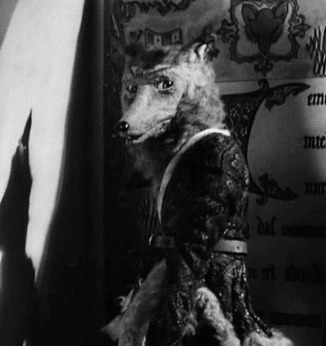
This film story revolves around Reineke Fox (Reynard the Fox), a cunning and sly anthropomorphic fox who is known for his cleverness and deceitful behavior. Throughout the film, Reynard engages in various adventures and misadventures, often outwitting other animal characters such as the wolf, the bear, and the lion. His fox behavior eventually draws the ire of the king, who promptly orders an attack on his castle.
The film is known for its satirical and often humorous take on human society, politics, and moral values, using the animal characters to comment on human behavior and societal issues. "The Tale of the Fox" is considered a classic in the history of animation. Moreover, it is important to note that Reynard the Fox is a prominent character in European folklore and literature, different adaptations and retellings of his stories can vary in details and themes.

In both Europe and United States, as I mentioned, art and animation were really taking off as major forms of entertainment and becoming popular. Because of this, "The Tale of the Fox" received a very warm reception. In fact, certain American production companies extended invitations for him to participate in the creation of larger-scale films. Nevertheless, he remained steadfast in his decision not to commercialize his art.
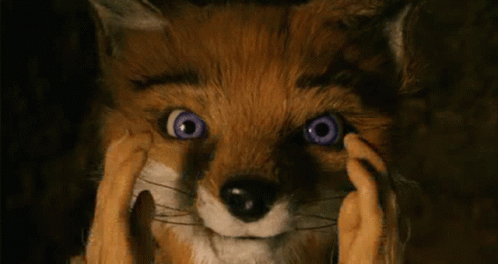
"Fantastic Mr. Fox (2009)" directed by Wes Anderson.
Finally, his incredible genius has influenced and inspired numerous directors over time, especially those in the horror genre. This influence can also be discerned in renowned works like "King Kong" and "Godzilla," as well as the films of directors such as Willis O'Brien, Tim Burton, and Wes Anderson.
In conclusion, Władysław Starewicz's enduring legacy as the pioneer of stop-motion animation is a testament to his unwavering commitment to his craft and artistic integrity. "The Tale of the Fox" stands as a testament to his dedication and innovation. His influence continues to echo through generations and genres, and will serve as a timeless reminder of the limitless possibilities in the world of animation.
If you have the opportunity, do not miss the chance to experience this remarkable work on Youtube, the video is attatched below.
youtube
Bibliography
The Tale of the Fox (1937) Retrospective (https://www.youtube.com/watch?v=QqIZ7lOEiEA)
https://culture.pl/en/artist/wladyslaw-starewicz
https://oforinvolvingmotionpictures.wordpress.com/2020/07/29/essential-the-tale-of-the-fox-1937/
http://notesfromhalfland.blogspot.com/2006/09/field-report-story-of-fox-le-roman-de.html
https://culture.pl/en/article/the-father-of-stop-motion-animation-a-secret-polish-history
#Youtube#animation history#2d animation#animation#writing#movies#thetaleofthefox#taleofthefox#fantastic mr fox#stop motion#animationblog#wes anderson#wladislaw starewicz
9 notes
·
View notes
Link
This week has been long.... Like really long! No holds bard or however the saying goes...
1 note
·
View note
Video
tumblr
9/4/17 Planning for the flip book
0 notes
Text
April 5
We discussed final cut and affect effects, neutral density filters, shooting with flat color and saturating in post, different types of cameras, using compressors/limiters, windscreens, having rich blacks, gain levels, color correcting, high and low frequencies, lavs. Lots of fun stuff!
0 notes
Photo

#NewPost on the blog! Read about my trip to Ireland and check out some of the pictures I took as well #aninationblogger #animationblog #animation #cartoonsaloon #brownbagfilms #animationstudio #ireland
#brownbagfilms#cartoonsaloon#animationstudio#animationblog#aninationblogger#ireland#newpost#animation
0 notes
Link
This Doctor Who/Adventure Time Mashup Is So. Damn. Charming.
0 notes
Text
'Fast and Furry-ous' (1949): The Short Film Debut of Wile E. Coyote and Roadrunner in the Looney Tunes Cartoons
By Sofi Ojeda
(7 min reading)
In 1940s decade, the world of animation had advanced to the point where people could enjoy cartoon films in theaters with sound and color, at least in the United States. Looney Tunes comprised a series of animated short films created by Warner Brothers Inc, founded in 1923. They began producing animation in 1930, initially influenced by the success of Walt Disney's Mickey Mouse.

Images from the short Fast and Furry-ous" (1949) Directed by Chuck Jones
Over the subsequent decade, a host of beloved characters were introduced to audiences, such as Porky Pig, Daffy Duck, and Bugs Bunny, the latter of whose authentic persona shone in "A Wild Hare" (1940). A few years later, in 1949, "Fast and Furry-ous," directed by Chuck Jones, emerged, signifying the inaugural appearance of the iconic Coyote and Road Runner duo, which is the focus of our discussion today.

Images from the short Fast and Furry-ous" (1949) Directed by Chuck Jones
"Fast and Furry-ous" humorously portrays the Coyote's futile attempts to catch the Road Runner in a desert canyon crisscrossed by freeways, often relying on products provided by the well-known but notoriously unreliable Acme Company. As an interesting aside, in the early stages of his design, Wile E. Coyote's name was Don Coyote, possibly a nod to Don Quixote, the delusional but noble-hearted gentleman who envisions himself as a chivalrous knight in the classic novel "Don Quixote" by Miguel de Cervantes. Analogously, Wile E. comically persists with constant schemes to catch the Road Runner but often finds himself in absurd and humorous predicaments, creating an almost delusional sense of knightly adventure.
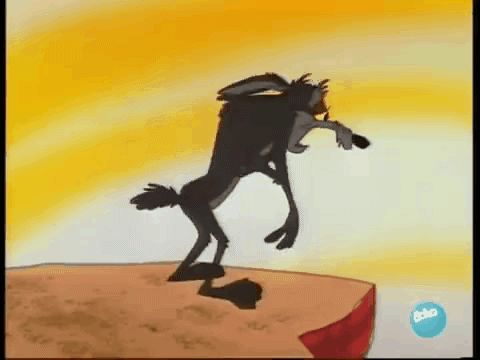
This GIF is not the short Fast and Furry-ous" (1949)
There was a three-year gap between this and the second Road Runner cartoon, "Beep, beep" (1952). Chuck Jones initially intended it as a one-shot cartoon but changed his mind due to positive public reception, notably a letter from a Naval Air Force captain who mentioned pilots mimicking the Road Runner's call during maneuvers.
This cartoon came to life during an era when people were looking for an escape from the challenges of the Great Depression and the post-World War II economic strains. Astonishingly, the ingenious and imaginative humor in the film retains its relevance in 2023, firmly establishing it as a timeless classic. I believe it consistently offers solace to viewers by presenting characters in more trying predicaments than those found in their ordinary lives.

Images from the short Fast and Furry-ous" (1949) Directed by Chuck Jones
In terms of technical aspects, the animation adhered to tradition, and character model sheets from that era still exist. Narratively, it adhered to a common formula of a protagonist's repeated failures leading to a series of mishaps. Although this wasn't the Coyote's initial character design, as he had appeared in a Looney Tunes comic a few months earlier, some argue that it still counts as his first appearance since he had a different name in the comics. Lastly, The Road Runner's famous "Beep, Beep!" was inspired by the background artist Paul Julian, who made the sound while dashing through the animator's offices.
"Fast and Furry-ous" remains a historical gem that viewers can watch on Vimeo. It serves as a testament to the enduring appeal of Looney Tunes and the remarkable legacy of Chuck Jones's contributions to animation.
vimeo
Full short film Fast and Furry-ous" (1949) Directed by Chuck Jones
Biography
https://www.imdb.com/title/tt0041349/trivia/?ref_=tt_trv_trv
Youtube Channel: The Looney Tunes Critic Video: Fast and Furry-ous | Looney Tunes Critic Commentary
https://drgrobsanimationreview.com/2012/12/24/fast-and-furry-ous/
https://www.britannica.com/biography/Friz-Freleng
https://www.imdb.com/title/tt0041349/
#2d animation#animation#coyote#road runner#looney tunes#looney toons#warner bros#warner brothers#chuck jones#animationblog#animation history#animated#Vimeo
4 notes
·
View notes
Text
Exploring Lotte Reiniger's 'Cinderella' Through the Eyes of a Silhouette Animator and Feminine Depth
(5 minutes reading)
By Sofi Ojeda

Lotte Reiniger, a trailblazing German animator renowned for her pioneering work in paper silhouette animation, has had a profound impact on the animation industry. Inspired by ancient Asian performances, Reiniger's legacy extends beyond her creation of the first full-length animated feature film, "The Adventures of Prince Achmed (1926)".
Today, we explore one of her lesser-known yet highly significant earlier works, "Aschenputtel" (Cinderella), crafted in 1922. This journey allows us to appreciate Reiniger's artistic brilliance and invites us to delve into the deeper layers of meaning within this classic fairy tale.
Understanding the Narrative
An intriguing element that I loved of this 12-minute short film lies in its opening sequence, where we witness Reiniger's hands meticulously crafting the paper main character Cinderella. Notably, Reiniger imbues the scissors with a character of their own, introducing them as a threat to Cinderella. This powerful and symbolic commencement aligns seamlessly with the film's overarching narrative: "Cinderella" is a young woman who manages to defy formidable challenges and secures an invitation to a royal ball, ultimately winning the affection of a prince, or as she eloquently phrases it:
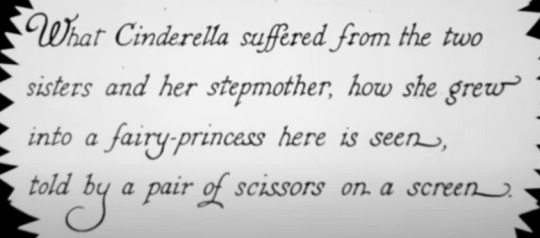
(Indeed, she also created these stunning English-written cards.)
Silhouette Animation Technique
Reiniger employed a frame-by-frame photography technique using multiple layers of cut-out paper. By adjusting opacity and composition, she crafted an illusion of depth in a multiplane camera—a technique later adopted by Walt Disney. Adding depth to the character designs through exaggeration, shape language and acting. Even the inanimate objects in the film are imbued with a distinct German expressionism style—distorted yet still legible. Remarkable for its time and the work of a single individual.
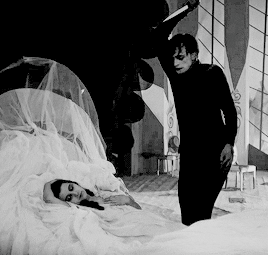
(German expressionism movie: The Cabinet of Dr. Caligari (1920))
Feminine Insights
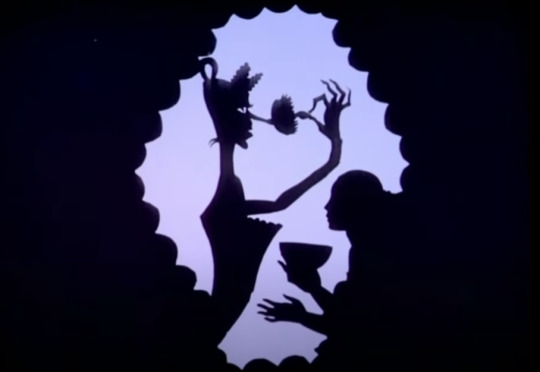
Reiniger's "Cinderella" isn't just a retelling of the classic fairy tale—it's an exploration of femininity, vanity, and competition among women. The film uses humor, such as the comically exaggerated eye movements of characters, to ridicule vanity. It reflects a historical perspective where differences in femininity were exploited for competition. Today, we recognize that there's no one way to be feminine, and no one is better or worse for their choices.
youtube
In the tale, her stepsister goes to extraordinary lengths, even resorting to cutting a part of her own feet to squeeze into Cinderella's shoe. This vividly illustrates how, in the past, cinema and television often portrayed the extraordinary measures women were willing to take to gain acceptance and validation from figures like princes or men in general. While we may find her stepsister's actions unconventional, it offers a poignant glimpse into the immense hurdles women confronted in their quest to meet societal expectations, as they strived to fit into predefined molds and be valued accordingly.
A Lasting Legacy
Reiniger produced two unique adaptations of this story. The first (this one), is a silent version that closely follows the German Grimm rendition, replacing the fairy godmother with a magical tree. And the second was her 1954 version, which reintroduced the fairy godmother, along with components like a pumpkin coach and mouse footmen, despite the story's origin in Perrault's version.
Reiniger's "Cinderella" has left a lasting impact. It's intriguing to note that subsequent adaptations, including Disney's iconic version, have closely followed the story's original narrative. Cinderella's tale is one of the most remade stories in cinematic history, with over 100 adaptations on the big and small screens.
youtube
If you're curious to experience this classic work, here I attatched "Cinderella" short film (posted on YouTube), where its timeless charm continues to captivate audiences, just as it did nearly a century ago.
Bibliography
The Art of Lotte Reiniger, 1970 | From the Vaults (on youtube)
Movie: The Cabinet of Dr. Caligari (1920)
Blogs:
https://moviessilently.com/2018/03/18/cinderella-1922-a-silent-film-review/
https://www.skwigly.co.uk/100-greatest-animated-shorts-cinderella-lotte-reiniger/
http://www.screenonline.org.uk/people/id/528134/index.html
#2d animation#animation#writing#art#movies#1920sanimation#lotte reiniger#cinderella#movie critique#movie critic#short film#animation history#animationblog#Youtube
3 notes
·
View notes
Text
Insight the Article: Groovin' to ancient Peru: A Critical Analysis of Disney's The Emperor's New Groove by Helaine Silverman
By Sofi Ojeda
(7 min reading / 1 page and a half essay)
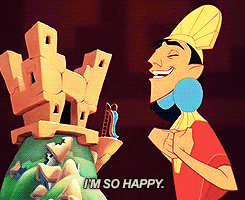
Delving into various analyses of animation often circles back to Disney, dominating the information available about animation in general. Seeking content closer to my roots as a South American woman, I stumbled upon a significant critical article. This article profoundly examines how major media platforms depict cultural heritage, influencing their audiences. Notably, it was written by a recognized archaeologist, an expert on the topic covered in one of my favorite movies: "The Emperor's New Groove (2000)," which, unsurprisingly, it had to be a Disney film.
Although I grew up just two hours away from various native cultures and near other Incan ruins in Ecuador, I don't feel capable of narrating a story from a perspective that I didn't grow up in. It's like how I relate to the challenges of women's representation in media due to the prevalent male gaze. Finding an accurate portrayal of females is difficult because this perspective often depicts women through the lens of individuals who lack firsthand experience of living as a woman. I believe this applies to cultural heritage as well, and it's a topic open for discussion. However, the article illustrates numerous examples of how this issue can affect the portrayal of cultures, particularly by highlighting inconsistencies.
Quote from the article:
"...Even committing to an official movie poster for Kingdom in the Sun (the old name of the movie*). Nevertheless, Disney apparently could not work out its relationship to the real archaeological past of Peru, since the poster shows a distinctly Mayan temple." - H. Silverman
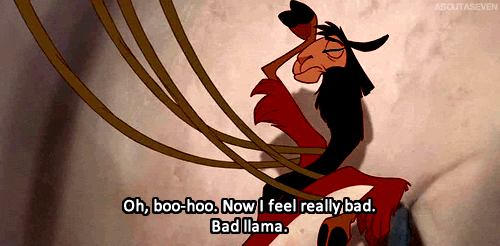
Something that surprised me about the article is how easy it was to read. Additionally, it's rich in Disney facts, encompassing the entire story of how the movie was initially planned as 'The Kingdom of the Sun,' aiming to be more historically accurate. The article contains interviews and research highlighting the lack of archaeological knowledge or desire to create a more historically meaningful film.
‘Roy Disney revealed while talking to Empire Online that Kingdom “began life as a pretentious non-spoofy kind of movie about the Inca, the Andes and all of the folklore about Sun Gods. It was really, really boring” ’- Silverman H.
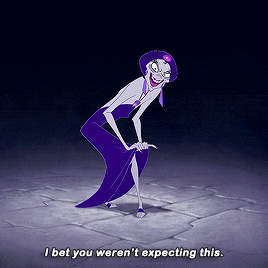
In her article, Dr. Helaine Silverman says the movie purposefully omits naming the ancient civilization, making it unidentifiable to the average American viewer. This approach mirrors a larger pattern seen in Disney films, aiming for "recognizable moments that are universal," often at the expense of fully capturing the depth and authenticity of depicted cultures.
This article's critical analysis unveils Disney's approach to cultural representation, highlighting its tendency to simplify, exoticize, objectify historical contexts and appropriate cultures without acknowledgment. The insights encourage deeper introspection into how movies like "The Emperor's New Groove" perpetuate stereotypes, urging readers to look beyond surface-level portrayals and seek a genuine understanding of cultures in entertainment. These actions raise deeper concerns related to contemporary discussions on representation, such as simulacra, postmodern spectatorship, the dissolution of cultural identity, and the implications of placelessness and travel in media narratives.
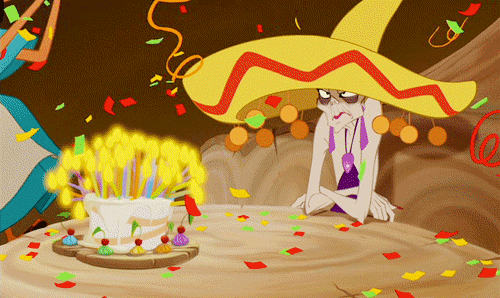
It is important to mention that Helaine Silverman is a renowned archaeologist and cultural researcher, she currently holds the title of Full Professor in the Department of Anthropology and directs CHAMP/Collaborative for Cultural Heritage Management. Possessing a Ph.D. in archaeology, her scholarly contributions have earned her acclaim in academic spheres. She explores the interplay between media, public interest in history, and Peru's incorporation of ancient civilizations in shaping its national identity. Her extensive academic career spanning close to three decades has primarily revolved around the archaeology of Peru's southern coastal region.
''They are not innocent errors. They are the result of a very particular attitude in the Disney studio that essentializes, exoticizes and objectifies the past and those who created it.''- Silverman H.
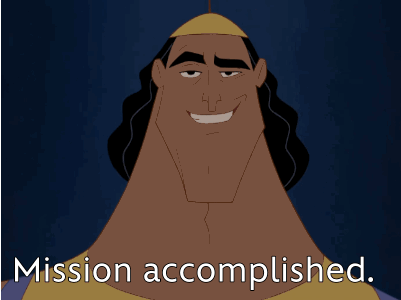
I would highly recommend this article, not just to gain insight into Inca culture, which extends beyond Peru, but also to highlight the significance of being mindful in how we depict minorities and challenge the romanticized, fictionalized versions often perpetuated by mainstream media. The excerpts underscore the importance of respecting and comprehending cultures without appropriating or mystifying them for commercial purposes, emphasizing the critical need for genuine and respectful representation in media.
Bibliography
Full article: https://citeseerx.ist.psu.edu/document?repid=rep1&type=pdf&doi=9350dc757bb6628baff9a0cec169056810b4639b
Silverman, H. (2002). Groovin’to ancient Peru: A critical analysis of Disney’s The Emperor’s New Groove. Journal of Social Archaeology, 2(3), 298-322.
Video: https://www.youtube.com/watch?v=OvGsh5H5RoE
https://publish.illinois.edu/helainesilverman/
https://journals.sagepub.com/doi/abs/10.1177/146960530200200302
#2d animation#animation#animation history#animationblog#writing#movies#walt disney#helaine silverman#the emperors new groove#movie critique#film critique#disney animation#movie analysis#film analysis
2 notes
·
View notes